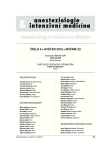The course of cytokine response in an animal model of intraabdominal sepsis modified by immunosuppression
Authors:
Ročeň Milan 1; Kieslichová Eva 1; Kudla Michal 2; Merta Dušan 1; Šplichal Igor 3; Čáp Jiří 1; Gürlich Robert 4
Authors‘ workplace:
Klinika anesteziologie, resuscitace a intenzivní péče, Transplantcentrum IKEM, Praha
1; Klinika transplantační chirurgie, Transplantcentrum IKEM, Praha
2; Oddělení imunologie a gnotobiologie, Mikrobiologický ústav AVČR, Praha
3; Chirurgická klinika, Fakultní nemocnice Královské Vinohrady, Praha
4
Published in:
Anest. intenziv. Med., 23, 2012, č. 2, s. 91-96
Category:
Intensive Care Medicine - Original Paper
Overview
Objective:
The diagnosis of sepsis in immunocompromised patients is difficult due to their modified response to infection. Our experiment was designed to compare the early clinical and laboratory response to sepsis between experimental groups of septic minipigs with and without immunosuppression.
Design:
Experimental, comparative study.
Material and methods:
Experiment was performed on minipigs. Sepsis was induced using a model of caecal ligation and puncture (CLP). Minipigs (with identical baseline parameters) were randomized into 3 group; the sepsis group (n = 10), the immunosuppression group (n = 11), which received immunosuppressive drugs (cyclosporine, methylprednisolone, mycophenolate mofetil) before surgery, and the sham group (n = 6). Plasmatic levels of selected cytokines throughout the experiment in three-hour interval were monitored.
Results:
All CLP animals developed septic shock with febrile and hemodynamic response. Also the kinetics of the plasma levels of TNFα, IL-1β, interferon-γ and CRP in both experimental groups with and without immunosuppression was similar. In immunosuppressed animals the levels of IL-4 were significantly lower in all time periods observed, on the contrary a significant increase of IL-8 levels in the same experimental group was found as well. Ten hours after surgery, significantly higher level of IL-6 was found in the sepsis group as compared to the immunosuppression group. There was a significantly greater increase in levels of IL-10, 19, 22 and 25 hours after surgery in immunosuppressed animals compared to the group without immunosuppression.
Conclusion:
We found significant differencies in cytokine response to experimental sepsis between the groups of immunocompetent and immunosuppressed animals in our experiment.
Keywords:
sepsis – immunosuppression – cytokine – caecal ligation and puncture – minipig
Sources
1. Trecziak, S. et al. Infections and severe sepsis in solid-organ transplant patiens admitted from a university-based ED. Am. J. Emerg. Med., 2004, 22, s. 530–533.
2. Seville, M.T., Kystofiak, S., Kusne, S. Infection kontrol issues after solid organ transplantation. In Bowden, R. A., Ljungman, P., Snydmyn, D. R. Transplant Infection. London: Lippincott Williams & Wilkins, 2010, s. 667–688.
3. Kumar, A. et al. Initiation of inapropriate antimicrobial therapy results in fivefold reduction of survival in human septic shock. Chest, 2009, 136, s. 1237–1248.
4. Iwamura, H., Sato, M., Wakitani, K. Comparative study of Glucocorticoids, Cyklosporine A, and JTE-607 [(-)-Ethyl-N- -{3,5-dichloro-2-hydroxy-4-[2-(4-methylpiperazin-1-1)ethoxy]benzoyl}-L-fenylalaninate Dihydrochloride] in a mouse septic shock model. JPET, 2004, 311, s. 1256–1263.
5. Opal, S. M., Cross, A. S. The use of immunocompromised animals as model for human septic shock. Shock, 2005, 24, s. 64–70.
6. Belikoff, B., Buras, J. A. A practical approach to animal model of sepsis. In Conn, P. M. Sourcebook of models for biomedical research. New York: Humana Press Inc., 2008, s. 473–483.
7. Rittirsch, D., Hoesel, L. M., Ward, P. A. The disconnect between animal model sof sepsis and human sepsis. J. Leukoc. Biol., 2007, 81, s. 137–143.
8. Lunney, J. K. Advances in swine biomedical model genomics. Int. J. Biol. Sci., 2007, 3, s. 179–184.
9. Levy, M. M. et al. 2001 SCCM/ESICM/ACCP/ATS/SIS International Sepsis Definitions Conference. Crit. Care Med., 2003, 31, s. 1250–1256.
10. Dellinger, R. P. et al. Surviving Sepsis Campaign: International guidelines for management of severe sepsis and septic shock. Crit. Care Med., 2008, 36, s. 296–327.
11. Sheiermann, P. et al. Comparing hemodynamics, blood gas analyses and proinflammatory cytokines in endotoxemic and severely septic rats. Int. Immunopharmacol., 2011, 11, 6, s. 719–723.
12. Taylor, A. L., Watson, C. J., Bradley, J. A. Immunosuppressive agents in solid organ transplantation: Mechanisms of action and therapeutic efficacy. Crit. Rev. Oncol. Hematol., 2005, 56, s. 23–46.
13. Bouza, E., Loechs, B., Munoz, P. Fever of unknowm origin in solid organ transplant recipients. Infect. Dis. Clin. North, Am., 2007, 21, s. 1033–1054.
14. Sakr, Y., Sponholz, C., Tuche, F., Brunkhorst, R. A., Reinhart, K. The role of procalcitonin in fibrile neutropenic patiens: review of the literature. Infection, 2008, 36, s. 396–407.
15. Osuchowski, M. F., Welch, K., Siddiqui, J., Remick, D. G. Circulating cytokine/inhibitor profiles reshape the understanding of the SIRS/CARS kontinuum in sepsis and predict mortality. J. Immunol., 2006, 177, s. 1967–1974.
16. Kellum, J. A. et al. GenIMS Investigators. Understanding the inflammatory cytokine response in pneumonia and sepsis: results of the Genetic and Inflammatory Marker of Sepsis /GenIMS) Study. Arch. Intern. Med., 2007, 167, s. 1655–1663.
Labels
Anaesthesiology, Resuscitation and Inten Intensive Care MedicineArticle was published in
Anaesthesiology and Intensive Care Medicine

2012 Issue 2
Most read in this issue
- Validation of factors predicting difficult intubation
- Quality of life one year after discharge from the ICU
- A severe course of acquired haemophilia A – case report
- An audit of the i-gel supraglottic airway for general anaesthesia with spontaneous and controlled ventilation – the effect of ventilation mode and operator experience on device performance
